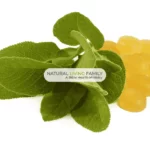When we’re sick, the last thing we want to give our bodies is sugar because it lowers our immune systems. But, we need something to relieve a sore throat or calm a cough. Store-bought cough drops are loaded with sugar and, many times, artificial colors and flavors. DIY cough drops can be customized with your favorite herbs, healing honey, and essential oils, and they’re so much better for you!
Table of Contents
Essential Oils for Sore Throat
We often lump respiratory issues and sore throat issues together when we reach for cough drops. Whatever bug you’re battling with at your house right now, there are essential oils that can help support your healing process.
It’s really not hard to make your own cough drops. You’ll use organic raw local honey, real herbs, pure essential oils, and everyone’s favorite… coconut oil! If you have a cold or feel a scratchy throat coming on, and you’ve made the cough drops recipe below, you can also utilize my immune boosting shot to give your system a head start.
Licorice – This is known as an expectorant. It helps to loosen and expel mucus from your lungs. It’s anti-inflammatory and will help soothe sore, irritated throats as well. (1)
Lavender – Popular for the familiar is calming fragrance, this essential oil is also antimicrobial and will help combat the underlying infection causing your sore throat or coughing.
Peppermint – How refreshing this oil can be for respiratory issues – it has a strong antitussive property for long-lasting, healing benefits.
Basil – Proven effective against even resistant strains of bacteria, basil essential oil may help you fight off the microbes causing your sore throat. (2)
Myrrh – Another strongly antimicrobial essential oil, this healing oil of the Bible also has oral health benefits, so it’s perfect to include in our homemade cough drop recipe!
This recipe is an adaption from one that my friend Katie put together for her blog, WellnessMama.com.

Homemade Cough Drops
Quantity
Ingredients
- 1 cup purified OR distilled water infused with organic herbs. (Try using slippery elm, coltsfoot, cinnamon, elderberry and chamomile)
- 1.5 cups raw organic local honey
- 2 tablespoons coconut oil, extra-virgin AND unrefined
- 20 drops essential oils*
Instructions
- Pre-mix coconut and essential oils (dilutes them to prevent burning your throat).
- Boil 2 cups of water and infuse with desired herbs. Use about ¼ cup of each herb for a really potent cough drop, but as little as 1 tablespoon of each herb is effective.
- To infuse: Pour boiling water over herbs. Put herbs in a muslin bag to make straining easier. Let steep for 20 minutes and strain out herbs (or remove the bag).
- Pour 1 cup of the herb-infused water and 1.5 cups of honey into a medium saucepan and turn on medium-high heat. (save the extra liquid and mix with equal parts raw honey for a simple cough syrup)
- Stir the honey/herb mixture over medium-high heat until it reaches 300 degrees. If you don’t have a candy thermometer, this usually takes about 30 minutes and can be tested by dropping a drop of the mixture into ice water to see if it immediately hardens. It should harden to the point that it breaks if dropped on the counter. You can also tell because the mixture will start to foam and separate. At this point, it is vital to remove it from the heat quickly so it does not burn.
- Mix in coconut oil and essential oil mixture and pour into candy molds, or pour into a large baking sheet that has been greased with coconut oil or that has a silicon baking mat on it.
- Let cool until it can be touched and molded and immediately and quickly form into lozenges with your hands (you might need help to do this quickly enough).
- Put finished cough drops/lozenges on a silicon mat or piece of parchment paper to cool.
- When completely cool, toss in a mixture of powdered slippery elm and stevia to keep from getting sticky in humidity.
- Use as needed for coughing, congestion, or sore throat.
Notes
- http://www.ncbi.nlm.nih.gov/pubmed/12804082
- http://www.sciencedirect.com/science/article/pii/S0167701203000125
- http://www.researchgate.net/publication/10813073_components_therapeutic_value_and_uses_of_myrrh











